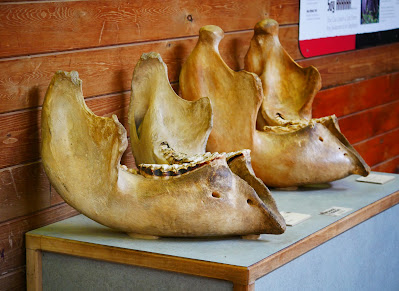The African elephants, and their bull Masai Giraffe were out and about and very visible. I've never had such good Elephant time in my previous visits. It's all part of the chance you take when you visit a good zoo where animals have autonomy over where they want to spend their time; even as it can also be disappointing.
NYALA
Tragelaphus angasii
Nyala are members of the genus Tragelaphus which is a reference to their spiral-twisting horns. As such they are "cousins" to other Antelopes often seen in zoos like: Lesser Kudus, Sitatungas, Eastern Mountain Bongos and Common Elands.
I believe from what I could discover that there are five female African Elephants resident at the Pittsburgh Zoo. On this wonderful morning, I was able to enjoy the presence of three of them.
AFRICAN BUSH ELEPHANT
Loxodontra africana
I also visited the Public area of the Elephant Barn and discovered a series of interactive displays to further engage and educate the visitor. I don't recall taking advantage of this in previous trips, or it wasn't open to the public at the times I visited.
The jawbones of elephants.
The impression of an adult Elephant's footprint. Guests could step inside of it to compare their foot with that of an Elephant.
Lewis is the Zoo's resident Bull Masai Giraffe. His companion female, Sox, passed into Ancestry back in January. Both animals were in the upper end of life expectancy. You can read Lewis' wisdom in the wrinkles he's earned across his expressive face.
MASAI GIRAFFE
Giraffa tippelskrichi
The Pittsburgh Zoo's latest Master Plan coupled with a recent $10 million dollar gift from an anonymous benefactor has spurred on the groundbreaking for a new, larger Giraffe Barn with state-of-the-art breeding capacity. Ground breaking is set to occur at the end of the summer. Very exciting development for the zoo.
















No comments:
Post a Comment